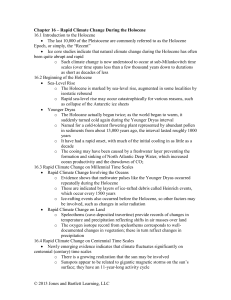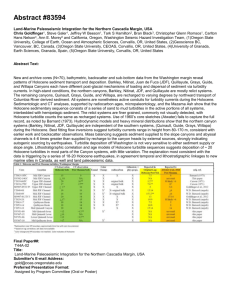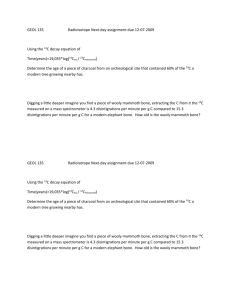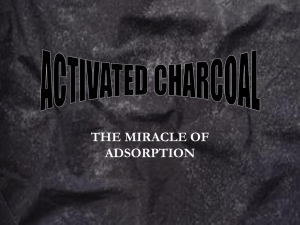DATA AND METHODS - Springer Static Content Server
advertisement
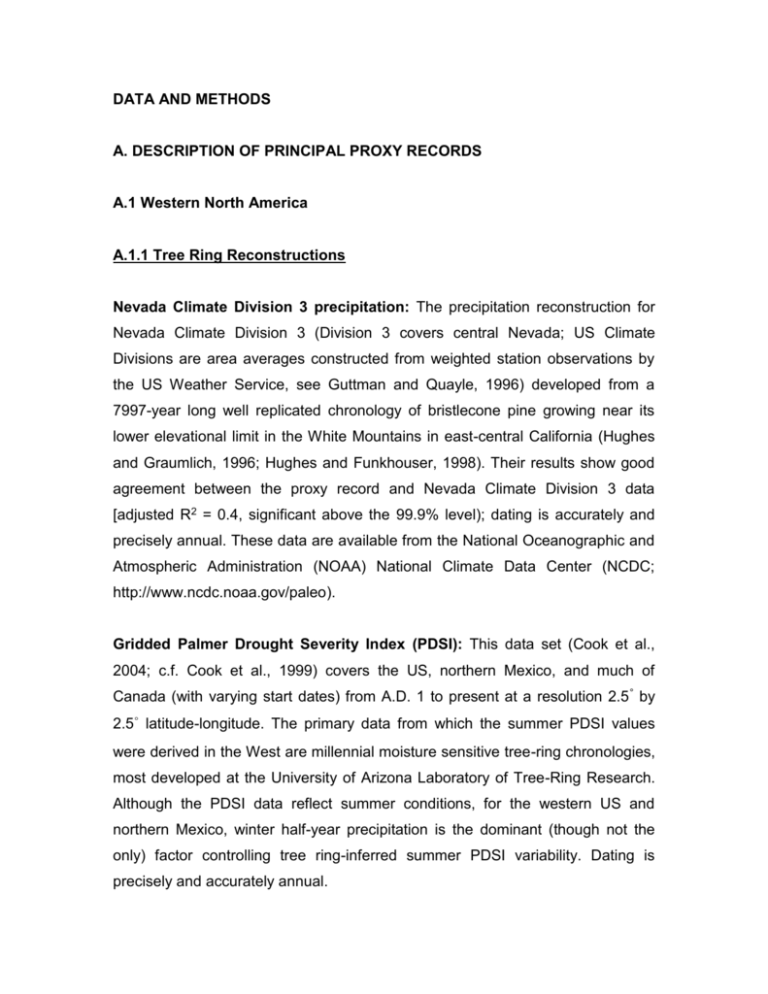
DATA AND METHODS A. DESCRIPTION OF PRINCIPAL PROXY RECORDS A.1 Western North America A.1.1 Tree Ring Reconstructions Nevada Climate Division 3 precipitation: The precipitation reconstruction for Nevada Climate Division 3 (Division 3 covers central Nevada; US Climate Divisions are area averages constructed from weighted station observations by the US Weather Service, see Guttman and Quayle, 1996) developed from a 7997-year long well replicated chronology of bristlecone pine growing near its lower elevational limit in the White Mountains in east-central California (Hughes and Graumlich, 1996; Hughes and Funkhouser, 1998). Their results show good agreement between the proxy record and Nevada Climate Division 3 data [adjusted R2 = 0.4, significant above the 99.9% level); dating is accurately and precisely annual. These data are available from the National Oceanographic and Atmospheric Administration (NOAA) National Climate Data Center (NCDC; http://www.ncdc.noaa.gov/paleo). Gridded Palmer Drought Severity Index (PDSI): This data set (Cook et al., 2004; c.f. Cook et al., 1999) covers the US, northern Mexico, and much of Canada (with varying start dates) from A.D. 1 to present at a resolution 2.5 ° by 2.5˚ latitude-longitude. The primary data from which the summer PDSI values were derived in the West are millennial moisture sensitive tree-ring chronologies, most developed at the University of Arizona Laboratory of Tree-Ring Research. Although the PDSI data reflect summer conditions, for the western US and northern Mexico, winter half-year precipitation is the dominant (though not the only) factor controlling tree ring-inferred summer PDSI variability. Dating is precisely and accurately annual. A.1.2 Pollen Reconstructions San Joaquin Marsh: This reconstruction (Davis, 1992; c.f. Boxt et al. 1999) is based on data from a sediment core taken from San Joaquin Marsh, a coastal Southern California wetland (approximately 50 km south of Los Angeles). The age model for the portion of the record used in this paper is based on five radiocarbon measurements with uncertainties of 100-200 years (just two dates are available since 2 kyr BP). Calibrated dates were obtained (by the present authors) using CALIB 4.4.2 (Stuiver and Reimer, 1993) using N. Hemisphere adjustments. The sampling resolution over the past few thousand years is relatively coarse (100-300 years). The index used in the record shown is Compositae (composite flowering plants) pollen fraction, and is interpreted as a measure of moisture availability (Davis, 1992). The San Joaquin Marsh data were made available by O. Davis. Lower Pahranagat Lake: This record is based on pollen analyses of two sediment cores (Wigand, 1997; Wigand and Rhode, 2002) taken from this shallow lake located about 150 km northeast of Las Vegas, in southern Nevada. The age model is based on 24 14C dates through the 5.6 kyrs in the core. The portion of the record used in this paper (covering the last 2 kyrs) has samples spaced about 14 years apart, each representing approximately four years. The index used here is the conifer-to-saltbush pollen ratio, a measure of moisture availability (i.e., winter precipitation); other indicators from the record indicate similar patterns of variability. Diamond Pond: This record was derived from a series of sediment cores from this site on the eastern slopes of the Cascade Range in south-central Oregon covering approximately 6 Kyrs (Wigand, 1987; Mehringer and Wigand, 1990). The age model is based on approximately 35 14C dates (all but a few from the last 3K years) from Diamond Pond and nearby sites, with typical uncertainties of 60-120 years supported by cross-dating with tephra (4 layers) and tree rings. Sampling over the past 150 years is continuous. Prior to that and back to 4 kyrs BP the sample interval is about 25-45 years, somewhat coarser for the earliest 1.4 kyrs of the record (back to 5.4 kyrs BP. Each sample represents 1-4 years of deposition during the recent 1000 years of the record and 5-10 years prior to that. The average years sample-1 for the entire record is ~5 years. The proxy index used here is ratio of juniper-to-grass pollen concentrations, an index sensitive primarily to winter precipitation (see Mehringer and Wigand, 1990). As with the Lower Pahranagat Lake data, other indices from the site (core pollen and charcoal, midden macrofossils) give a similar portrayal of regional climate change over the period of interest (cf. Miller and Wigand, 1994; Wigand and Rhode, 2002). The radiocarbon dates were calibrated by the present authors using CALIB 4.4.2 (Stuiver and Reimer, 1993) with N. Hemisphere adjustments. A.1.3 Charcoal and fire-scar records As discussed in detail in a number of papers, the interpretation of fire-related records (sediment charcoal records in particular) requires consideration of associated proxy evidence and process-related environmental factors (e.g., Clark et al., 1997; Swetnam and Betancourt, 1990; Swetnam, 1993; Whitlock and Millspaugh, 1996; Anderson and Smith, 1997; Gardner and Whitlock, 2001; Whitlock et al, 2004). In addition to fire-frequency and intensity, sediment charcoal records reflect the atmospheric dispersion of charcoal particles from their source (Clark, 1988; Gardner and Whitlock, 2001) and processes governing the transport of deposited charcoal from surrounding catchments into lake sediments (Whitlock et al., 2004). Aside from proxy-related issues, the low frequency variability in wild-fire occurrence is governed by a range of factors (e.g., Swetnam and Betancourt, 1990; Swetnam, 1993; Anderson and Smith, 1997; Whitlock, 2001; Swetnam and Baisan, 2002), including fuel availability (biomass) and moisture content, and can be affected not only by the average climate, but by climate variability (Swetnam and Betancourt, 1990; Swetnam and Baisan, 2002). For the sediment core records discussed here, the late Holocene low frequency changes in charcoal concentrations are interpreted primarily as reflecting changes in the intensity and frequency of wildfire occurring near the sites due principally to decreases in winter half-year precipitation, rather than changes in vegetation or secondary deposition of old charcoal from the surrounding catchment (Anderson and Smith, 1997; Mohr et al., 2000). As discussed later, this interpretation is strengthened by the similarity between the fire-related proxy records and others more directly related to climate variability. Crater Lake and Bluff Lake: These charcoal deposition rate records (Mohr et al., 2000) are from small lakes (1900 and 2300 m elevation, respectively) located about 7 km apart in the Klamath Mountains of central Northern California. The age model for Crater Lake is based on five 14C dates with two dates during the last 2.6 kyrs BP; that for Bluff Lake is based on eight dates, with two dates during the last 2.7 kyrs BP. Both age models were calibrated following Stuiver and Reimer (1993) and the recent calibrated dates have an uncertainty of 50-100 years [note: the age model used here for Crater Lake differs from that described in Mohr et al. (2000), and is that supplied with the data set available at NCDC]. The Bluff and Crater Lake data shown in this paper are charcoal deposition rates (particles > 250 micrometers cm-2 yr-1). Both data sets are available from NCDC. Central Sierra “Seven Meadows” Charcoal: This record (deposition rate; Anderson and Smith, 1997) is a composite constructed from cores taken in seven alpine meadows in the central Sierra Nevada (between 36N and 37.5N) at elevations between 1800-2200 m. Age control is from three to five 14C dates (50- 100 year uncertainties) from each site, typically with one or two dates from the last 2-3 kyr BP. The original 14C dates were calibrated by the present authors using CALIB 4.4.2 (Stuiver and Reimer, 1993). The data shown here are after Anderson and Smith (1997) and are used with the permission of S. Anderson. Giant Sequoia Groves: This fire-scar record (Swetnam, 1993) comes from five giant sequoia groves in the central California Sierra Nevada. The record used here consists of a chronology of number of groves with fire (yr-1). Dating is accurately and precisely annual. For the present paper, these data were processed to provide a binary event record for cases with and without >3 groves with evidence of fire in a given year, with this record beginning when the number of trees sampled per year reached 40 (314 AD). As discussed by Swetnam (1993), the number of trees sampled per year increased early in the first millennium AD. These data were kindly made available by T. Swetnam. A.2 Marine and coastal proxy records Santa Barbara Basin SST: This central California SST reconstruction (Kennett and Kennett, 2000) was developed from Globigerina bulloides (a near-surface dwelling foraminifera) δ18O from Ocean Drilling Program Core 893A in the Santa Barbara Basin. The SST reconstruction uses thermometry functions developed by Bemis et al. (1998) based on the modern inter-comparisons from southern California waters. The age model for Core 893A is based on 14C dating (four dates in the last 1500 years), with calibration using CALIB 3.0.3 (Stuiver and Reimer, 1993). The data sampling interval is approximately 25 years, with absolute dating uncertainty thought to be on the order of 50 years during the last 2 kyrs (see additional discussion of marine reservoir corrections in Kennett and Kennett, 2000; also Ingram and Southon, 1996; Kennett et al., 1997, Roark et al. 2003). These data agree well with a varve chronology established elsewhere in the Santa Barbara Basin (Schimmelmann et al., 2006) San Francisco estuary salinity – This salinity reconstruction (Byrne et al., 2001; Starratt, 2004) is based on diatom species distributions and supporting palynological evidence from a sediment core taken from a brackish marsh (Rush Ranch) in the upper reaches of San Francisco estuary (Suisun Bay, approximately 70 km from the entrance to San Francisco Bay). The age model based on four calibrated 14C dates (CALIB 3.03c; Stuiver and Reimer, 1993) over the past approximately 2.6 kyr BP, with the most recent calibrated date at about 760 AD [R. Byrne (personal communication) gives this as the most recently obtained median date from a Scirpus (sedge) seed (730 AD is given in Byrne et al., 2001), and has good confidence that it marks the surface of the marsh at that time]. Age model uncertainties are on the order of 50-200 years. The changes in diatom taxa abundances and plant distributions are interpreted as indicating changes in salinity due to low frequency variability in discharge from the Sacramento / San Joaquin River systems that drain the Central Valley of California. This discharge in turn reflects autumn-spring precipitation and late spring-early summer snowmelt from the Sierra Nevada. The Rush Ranch data were kindly provided by S. Starratt. Palmyra Island fossil coral – NINO3.4: This reconstruction of central tropical Pacific SST was developed from multiple sections of fossil coral from Palmyra Island (6°N, 162°W; Cobb et al., 2003) using δ18O-inferred thermometry. Palmyra lies at the northwest fringes of the equatorial Pacific cold tongue, and the systematic effect of El Niño variability on the isotopic record is indicated by the correlation of -0.84 between with 2-7 year band-passed δ18O and the Kaplan et al. (1998) NINO3.4 SST (area-average for the region 170-120°W; 5°N-5°S) instrumental record reconstruction conservatively assuming an over independent the value period 1886-1998 every 7 [very years (giving approximately 16 degrees of freedom for the 113 year record), the correlation is significant well above the 99% level as assessed using Fisher’s z-transform (David, 1949)]. The close relationship between coral δ18O and equatorial SST reflects the response to changes in both water temperature and ocean water isotopic concentration (due to changes in relative contributions from equatorial upwelling and precipitation) that accompany El Niño variability at Palmyra. The age model is based on U-Th dates and cross-matching of overlapping coral segments with sub-annual sampling and is thought to have an uncertainty of 5-10 years in the earlier segments of the record. The Palmyra data used in this paper were developed from the original over-lapping sub-annual resolution data (see Cobb et al., 2003) to a single series of annual (nominally June-May) averages. Analyses of the sub-annually resolved data show negligible differences in the low frequency variability when stratified by season. Western equatorial Pacific (Mindanao) SST: This reconstruction is based on Mg/Ca thermometry from near-surface foraminifera in IMAGES Core MD98-2181 from just south of Mindanao in the northwest equatorial Pacific (6˚N, 126˚E; Stott et al., 2004). The age model for the core is based on eighteen 14C dates (five from the past 1.5 kyrs) with an age uncertainty on the order of 100-300 years, with calibration using CALIB 4.4 (Stuiver and Reimer, 1993; marine reservoir correction of 600 years). Peruvian riverine sediment record: These data (Rein et al., 2004, 2005) are from an ocean sediment core (SO147-106KL) taken approximately 80 km off the central Peruvian coast (12˚ S). The chronology is based on 14C dates (8 over the past 2.5 kyrs) calibrated using CALIB 4.4 (Stuiver and Reimer, 1993; marine reservoir correction 800 years). In this paper we use the concentration of terrestrial-derived material (the “lithics” record in Rein et al., 2004), indicative of riverine sediment discharge associated with El Niño-related precipitation episodes in northern Peru. The data for the lithics record were continuously (optically) sampled resulting in per sample resolution of 1-4 years. REFERENCES Anderson, R. S., and S. J. Smith, 1997: The Sedimentary Record of Fire in Montane Meadows, Sierra Nevada, California, USA, in Sediment Records of Biomass Burning and Global Change, J. Clarke, H. Cachier, J. G. Goldammer, and B. Stocks, Eds., NATO ASI Series, Springer, pp. 313-328. Bemis, B. E., H. J. Spero, J. Bijima and D. W. Lea, 1998: Reevaluation of the oxygen isotope composition of planktonic foraminifera: Experimental results and revised paleotemperature equations, Paleoceanography, 13, 150-160. Boxt, M. A., L. M. Raab, O. K. Davis, and K. O. Pope, 1999: Extreme late Holocene climate change in coastal California, Pacific Coast Archeological Society Quarterly, 35, 25-37. Byrne, R., B. L. Ingram, S. Starratt, F. Malamud-Roam, J. N. Collins, and M. E. Conrad, 2001: Carbon isotope, diatom, and pollen evidence for late Holocene salinity change in a brackish marsh in the San Francisco estuary, Quat. Res., 55, 66-76. Clark, J. S., 1988: Particle motion and theory of charcoal analysis: source area, transport, deposition, and sampling, Quaternary Research, 30, 67-80. Clark, J.S., H. Cachier, J.G. Goldammer and B. Stocks (eds.) 1997: "Sediment Records of Biomass Burning and Global Change". NATO ASI Series, Vol. I 51: 313-327. Cobb, K. M., C. D. Charles, H. Cheng, and R. L. Edwards, 2003: El Niño/Southern Oscillation and tropical Pacific climate during the last millennium, Nature, 424, 271-276. Cook, E. R., D. M Meko, D. W. Stahle, and M. Hughes, 1999: Drought reconstructions for the Continental United States, J. Clim., 12, 1134-1144. Cook, E. R., C. Woodhouse, C. M. Eakin, D. M. Meko, and D. W. Stahle, 2004: Long-term aridity changes in the western United States, Science, 306, 10151018. David, F. N. "The Moments of the and Distributions." Biometrika 36, 394-403, 1949. Davis, O., 1992: Rapid climate change in coastal southern California inferred from pollen analysis of San Joaquin Marsh, Quaternary Research, 37, 89-100. Gardner, J. J. and C. Whitlock, 2001: Charcoal accumulations following a recent fire in the Cascade Range, northwestern USA, and its relevance to fire-history studies, Holocene, 11, 541-549. Guttman, N. B. and R. B. Quayle, 1976: A historical perspective of U.S. Climate Divisions, Bull. Amer. Met. Soc., 77, 293-303. Hughes, M. K. and L. J. Graumlich, 1996: Climatic variations and forcing mechanisms of the last 2000 years, NATO ASI Series, Vol. 141: Multi-millenial dendro-climatic studies from the western United States, pp. 109-124. Hughes, M. K. and G. Funkhouser, 1998: Extremes of moisture availability reconstructed from tree-rings from recent millennia in the Great Basin of Western North America, Impacts of Climate Variability on Forests, eds. M. Beniston and J. L. Innes, 99-107, Berlin, Springer. Ingram, B. L. and J. R. Southon, 1996: Reservoir ages in eastern Pacific coastal and estuarian waters, Radiocarbon, 38, 573-582. Kaplan, A., M. A. Cane, Y. Kushnir, B. Blumenthal, and B. Rajagopalan, 1998: Analysis of global sea surface temperature 1856-1991, J. Geophys. Res., 101, 22599-22617. Kennett, D. J., B. L. Ingram, J. Erlandson, and P. Walker, 1997: Evidence for temporal fluctuations in marine reservoir ages in the Santa Barbara Channel Region, California, J. Archeological Sciences, 24, 1051-1059. Kennett, D. J., and J. P. Kennett, 2000: Competitive and cooperative responses to climatic instability in coastal southern California, Amer. Antiquity, 65, 379-395. Mehringer, P. J., and P. E. Wigand, 1990: Comparison of Late Holocene Environments from woodrat middens and pollen: Diamond Craters, Oregon, in Fossil Packrat Middens: The Last 40,000 Years of Biotic Changes, J. L. Betancourt, T.R. Van Devender, and P. S. Martin, Eds., University of Arizona Press, Tucson. Miller, R. F. and P. E. Wigand, 1994: Holocene changes in semarid PiñionJuniper woodlands: Response to climate, fire, and human activities in the US Great Basin, BioScience, 44, 465-474. Mohr, J. A., Whitlock C., and Skinner C. N. 2000: Postglacial vegetation and fire history, eastern Klamath Mountains, California, USA, Holocene, 10, 587-601. Rein. B., A. Lückge, and F. Sirocko, 2004: A major Holocene ENSO anomaly in the Medieval period, Geophys. Res. Lett., 31, L17211, doi:10.1029/2004GL020161. Rein. B., A. Lückge, Reinhardt, L. F. Sirocko, A. Wolf and W.-C. Dullo, 2005: El Niño variability off Peru during the last 20,000 years, Paleooceanography, 20, doi:10.1029/2004PA001099. Roark, E. B., B. L. Ingram, J. R. Southon, J. P. Kennett, 2003: Holocene foramineferal radiocarbon record of paleocirculation in the Santa Barbara Basin, Geology, 31, 379-382. Schimmelmann, A., C. B. Lang, B. J. Meggars, 2003: Paleoclimatic and archeological evidence for a 200-yr recurrence of floods and droughts linking California, meso-, and South America over the past 2000 years, Holocene, 13, 763-778. Starratt, S. W., 2004: Diatoms as indicators of late Holocene freshwater flow variations in the San Francisco Bay estuary, central California, USA, in Proceedings of the Seventeenth International Diatom Symposium, Ottawa, Canada, 25th – 31st August 2002, M. Poulin, ed., pp. 371-397, Biopress Limited, Bristol, UK. Stott, L. D., K. G. Cannariato, R. Thunell, G. H. Haug, A. Koutavas, and S. Lund. 2004: Decline of surface temperature and salinity in the western tropical Pacific Ocean in the Holocene epoch. Nature, 431, 56-59. Stuiver, M. and P.J. Reimer, 1993: Extended 14C data base and revised CALIB 3.0 14C Age calibration program, Radiocarbon, 35, 215-230. Swetnam, T. W. and J. L. Betancourt. 1990: Fire-Southern Oscillation relations in the Southwestern United States. Science, 249, 1017-1021. Swetnam, T. W., 1993: Fire history and climate change in Giant Sequoia Groves, Science, 262, 885-889. Swetnam, T. W., and C. H. Baisan, 2003: Tree ring reconstructions of fire and climate history in the Sierra Nevada and southwestern United States, in Fire and Climatic Changes in Temperate Ecosystems of the Western Americas, T. T. Veblen, W. L. Baker, G. Montenegro, and T. Swetnam, eds., Ecological Studies 160, Springer-Verlag, New York, pp. 158-195. Whitlock, C., and S. H. Millspaugh, 1996: Testing assumptions of fire history studies: an examination of modern charcoal accumulation in Yellowstone National Park, Holocene, 6, 7-15. Whitlock, C., 2001: Variations in Holocene Fire frequency: a view from the western United States, Biology and Environment: Proc. Roy. Irish Academy, 101B, 63-77. Whitlock, C., C. N. Skinner, P. J. Bartelien, T. Minckley and J. A. Mohr, 2004: Comparison of charcoal and tree-ring records of recent fires in the eastern Klamath Mountains, California USA, Can. J. For. Res., 34, 2110-2121. Wigand, P. E., 1987: Diamond Pond, Harney County, Oregon: Vegetation history and water table in the eastern Oregon desert, Great Basin Naturalist, 47, 427458. Wigand, P. E., 1997: A late Holocene pollen record from Lower Pahranagat Lake, southern Nevada, USA: High resolution paleoclimatic records and analysis of environmental responses to climate change, in Proceedings of the Thirteenth Annual Pacific Climate (PACLIM) Workshop, Asilomar, CA, April 14-17, 1996. California Department of Water Resources Technical Report 53 of the Interagency Ecological Program for the Sacramento-San Joaquin Esturary, p. 6377. Wigand, P. E., and D. Rhode. 2002: Great Basin vegetation history and aquatic systems: The last 150,000 years. Pp. 309-367. In Hershler, R., D. B. Madsen and D. R. Currey (eds.), Great Basin Aquatic Systems History. Smithsonian Contributions to Earth Sciences 33. Smithsonian Institution Press, Washington, D.C.


